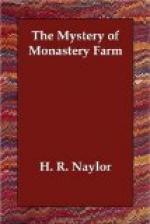So marked and intense was this feeling that a meeting of the faculty and trustees was called. Was this a modern Pentecost? So Worth said; so Cummings thought. A great meeting was held for consultation and the people were publicly invited. Everyone declared a church should be organized. The bishop was in favor of this, and at the proper time one hundred and eighteen persons presented themselves as candidates for confirmation. Up to this time what was known as Monastery was simply a scientific and theological seminary. Its faculty was composed of educated clergymen. It was a college with a bishop as president, supported by the church at large and the products of the farm, having a board of trustees to hold and manage the estate according to the laws of the commonwealth. Now it was to become an organized parish church and, in addition, the center of a diocese. The bishop was to assume the duties of the rector, with the members of the faculty as his assistants, and the trustees were incorporated as the “Board of Trustees of Monastery Church and College,” according to law. This was a new regime for Bishop Albertson, who, years before, had been rector of a small parish in Virginia. Even at that time he was a rigid churchman and a profound scholar, and because of these and other qualifications he had unexpectedly been elevated to the episcopal office. Soon after this well-merited promotion he had been earnestly requested to take this young seminary under his care and superintendence, and had cheerfully accepted this added responsibility. From that time he had made Monastery his home and the headquarters of his diocese. It continued to be “a school of the prophets” during ten years, when it was granted a university charter and it became a school of classics as well as theology. No one ever felt disappointed at this appointment of Bishop Albertson to the presidency of the institution, which under his care had grown from a small seminary with seventeen students to its present proportions and standing in the state. Now there were seventy-two theological students and two hundred and forty-five in the classical and scientific courses. This had been done under the fostering care and superintendency of the present incumbent. This institution had been simply a high-grade school of classics and theology, principally the latter. Experimental religion had but a small place in its curriculum or life. “Thou shalt not” of the Old Testament was strictly taught and demanded of all. But “Thou shalt” of the New Testament was rarely thought of, much less practiced. So apparent was this that critical observers used to say of it: “Here is where they have neither religion nor politics.” And this local adage was literally true. The highest morality was practiced and demanded, but the dogmas which insisted upon the regeneration of the heart and life were very sparingly taught. Morality in its highest life was demanded of all, but the inner life was left to take care of itself.




